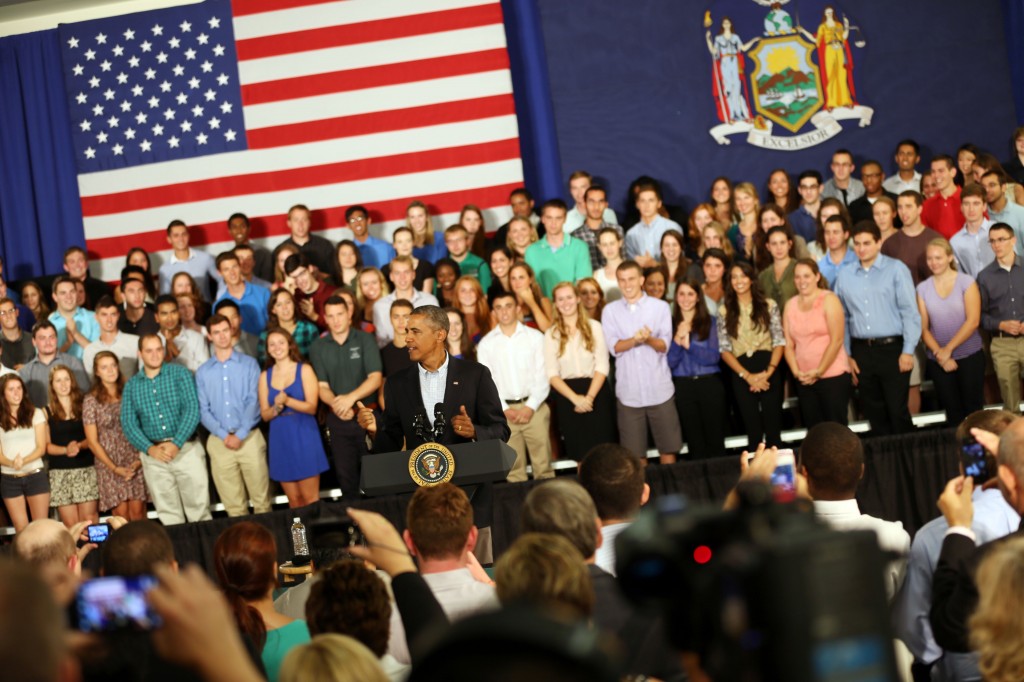
During his two-day bus trip around upstate New York and northern Pennsylvania last week, which included a town hall-style event at Binghamton University, President Barack Obama unveiled a new plan to lower the cost of higher education as part of a broader effort to increase access to the middle class.
The plan — unveiled in an address at the University at Buffalo on Thursday, Aug. 22 — is composed of three parts aimed not only at getting the cost of college down to a more affordable price range for middle-income families, but also at creating more efficient uses for funds for higher education.
“The fact is, college has never been more necessary, but it’s also never been more expensive,” the president said. “Think about this: Over the past three decades, the average tuition at a four-year public college has risen by more than 250 percent. The typical family income has gone up 16 percent … And families are making bigger and bigger sacrifices — including a lot of parents who are putting off their own retirement, their own savings, because they’re trying to help their kids afford a college education.”
The largest and most potentially controversial aspect of the plan is a new rating system for colleges and universities. The rating system, the details of which still need to be planned and formalized, would ultimately require congressional authorization.
The goal of the rating system would be to pick up where commercial systems, like Forbes or U.S. News & World Report, leave off.
According to Obama, commercial systems rank schools based upon factors like how exclusive they are, how few students they admit, how expensive they are and how nice their facilities may be. The newly proposed system would incorporate factors more relevant to selecting a cost-effective option for higher education. The president mentioned incorporating metrics like graduation rates, retention rates, the amount of debt students leave with and if they can find jobs after graduation that will enable them to pay off that debt.
“We want to create better incentives for colleges to do more with less and to deliver better value for our students and their families,” Obama said.
President Obama and Secretary of Education Arne Duncan have both announced plans to travel the country over the next year in order to speak with educators, students and administrators about the proposed plan in order to gain input and suggestions before the plan is premiered for the the 2015 school year, pending congressional approval.
Ultimately, the goal will be to attach the rating system to the amount of aid schools receive from the federal government. Higher-rated schools, or schools that show improvement in areas of increased competency or lower costs, will get more federal aid dollars than expensive schools whose graduates are weighed down with years of debt and no way to pay it back. The system would also provide incentives for schools that perform well in other areas — for instance, not only accepting Pell Grant recipients, but graduating them as well.
“There are schools out there who are terrific values. But there are also schools out there that have higher default rates than graduation rates. And taxpayers shouldn’t be subsidizing students to go to schools where the kids aren’t graduating,” Obama said. “That doesn’t do anybody any good.”
The rating system is only one part of the proposed plan. In his opening remarks at BU on Friday, Aug. 23, Obama mentioned that he will be putting pressure on state legislatures to restore funding to public universities and stop slashing budgets and raising tuition as a way to fund improvements, which he said thereby passes the costs on to students and taxpayers.
“Legislative priorities have shifted all across the country — more money into prisons, less money into schools. That means that costs are passed on to students in the form of higher tuition. So we’ve got to do something about that,” Obama said.
Obama also mentioned several ideas to ease the burden of one trillion dollars in outstanding student loan debt. Under his new plan, students will not be allowed to take out more loans or receive more grants until they finish the credits they are working on, thereby preventing situations in which students take on large amounts of debt without ever graduating.
“Nobody wants to take on debt,” he said, “but even if we do a good job controlling tuition costs, some young people are still going to have to take out some loans. But we think of that as a good investment because it pays off in time — as long as it stays manageable, as long as you can pay it back.”
Another aspect of the proposed higher education reforms will be to work with colleges and universities to come up with ways for students to graduate in less time to save money. Obama suggested wider spread implementation of online classes, dual degree programs and programs that enable high school students to earn credit before they get to college, shortening the time they have to pay for their degrees.
The final portion of the president’s plan involves expanding a program that is already in place. The Pay As You Earn program caps the loan repayments of recent graduates at 10 percent of their monthly disposable income.
“We already have that program in place, but it’s not as widely known as it needs to be, and not as many young people are eligible for it as we want them to be. So we’re going to work to improve on that front,” he explained.


